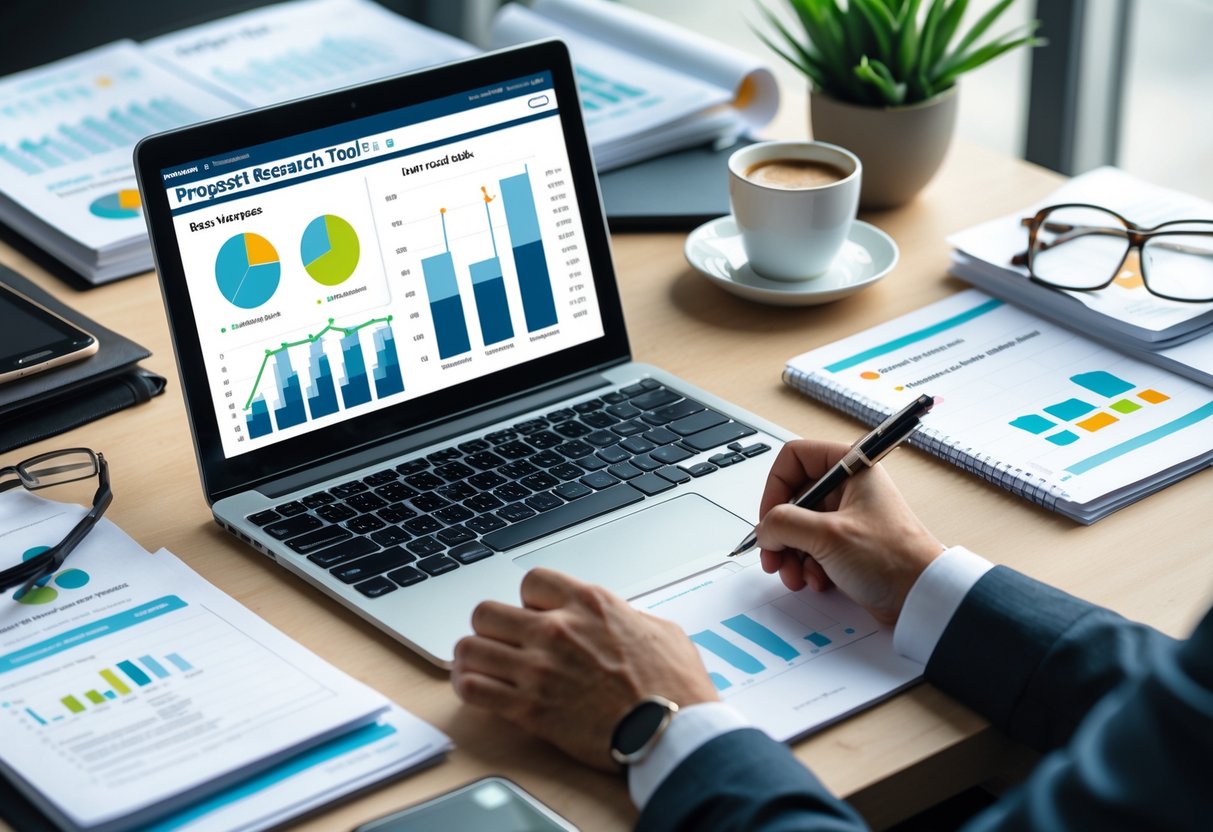Finding the right donors isn’t just luck or guesswork. You really need solid data to figure out who has both the means and the heart to support your mission.
Prospect research tools help you spot high-impact donors and build smarter fundraising strategies.

I lean on these tools to dig up wealth markers, past donations, and those little personal connections that make all the difference. With that info, I can focus on people who are actually likely to give, instead of wasting energy on dead-end leads.
A decent platform lets me weave donor insights right into the bigger fundraising picture. Wealth screening, relationship mapping—each tool brings something different to the table for outreach and impact.
Key Takeaways
- Prospect research tools show you who’s likely to support your cause
- They help you size up donor capacity, interest, and connections
- The right tools make fundraising more focused and less of a shot in the dark
Understanding Prospect Research Tools
I use prospect research tools to get a grip on a donor’s ability and interest in giving. These tools show me financial clues, past philanthropy, and personal ties, so my outreach gets sharper and more relevant.
What Are Prospect Research Tools
Prospect research tools are basically software that pulls and analyzes data about potential donors. They tap into public records, giving databases, and professional networks.
This way, I see not just who has money, but who’s actually given to causes like mine before.
With tools like DonorSearch or iWave, I can check out wealth markers, giving history, even board roles. That helps me figure out which donors are worth my time.
Instead of blind guessing, I get organized profiles that mix financial info with giving activity. That saves me so much time and helps me avoid barking up the wrong tree.
Key Benefits for Nonprofits
These tools save hours by automating what would otherwise be a mountain of manual research. I can screen dozens of names and instantly spot who’s worth a closer look.
Personalization is a big deal, too. If I know someone’s interests and giving patterns, I can actually talk to them like a person, not just another name on a list. Tools like GivingDNA even dig into donor behavior, so I get why someone gives.
Planning gets easier, too. With solid data, I can set real fundraising goals and even track how I’m doing with tools like Fundraising Report Card.
Prospect Research vs. Wealth Screening
People mix these up all the time, but they’re not the same. Wealth screening just looks at money—real estate, stocks, business connections.
Prospect research goes deeper, adding in giving history, personal ties, and what motivates someone to give. For example, Bonterra blends wealth screening with donor engagement tools, so I see the full story.
It matters because someone can be rich and still not care. Prospect research helps me find folks who both can and want to support what I’m doing.
Core Features of Prospect Research Tools

When I’m checking out these tools, I look for how well they reveal a donor’s ability, history, and willingness to give. The best platforms blend financial data, past giving, and personal connections to build out donor profiles that actually help me plan.
Capacity Indicators
Capacity indicators show me if someone can give big. I’m talking about real estate, stocks, and other assets that point to wealth. Tools might pull property records or business ties to estimate net worth.
Some platforms even sync with the SEC to track executive pay or stock sales. That gives me a sense of whether someone could make a major gift.
Political contributions are another clue. If someone’s giving to campaigns, there’s a good chance they have the means for philanthropy, too.
Philanthropic Indicators
Philanthropic indicators tell me how someone’s supported nonprofits before. That includes charitable gifts, foundation links, and bequests you can find in public records. If they’ve given a lot before, odds are they’ll do it again.
Tools like DonorSearch compile donation histories for nonprofits, schools, and arts groups. I can spot patterns—how often, how much, what kind of gifts.
Grant databases and philanthropic reports help me check if a donor likes annual gifts, big campaigns, or legacy stuff. Matching my ask to their habits beats guessing every time.
Affinity Indicators
Affinity indicators let me see if someone’s passions line up with my mission. It’s not just about money or history—it’s about what they care about.
I check alumni groups, boards, and volunteer work for personal ties to my cause. Platforms like GivingDNA use behavioral data to group donors by motivation, so I can tailor my approach.
Social and professional networks also show shared values or community links. When I combine this with wealth and giving data, I get a real sense of who’s likely to step up.
Top Prospect Research Tools and Software
I use prospect research tools to get accurate donor data, streamline outreach, and zero in on the people who’ll actually support my work. The right software lets me break down wealth, giving history, and connections, and honestly, it saves a ton of time.
DonorSearch
DonorSearch is my go-to for deep wealth and giving screening. It pulls from a huge research database—real estate, political gifts, business roles, and more. That way, I can judge both capacity and affinity before reaching out.
It connects with over 40 nonprofit CRMs, so my data stays in sync. DonorSearch also has AI-powered tools like DonorSearch Ai, which uses predictive models to rank prospects by their likelihood to give. That means I spend less time on the wrong people.
I like the ProspectView Online 2 feature—it gives quick, clear donor snapshots. With that, I can customize my outreach and skip the folks who aren’t likely to bite.
More details? Check DonorSearch prospect research tools.
iWave
For flexibility, I use iWave. It pulls info from sources like Candid and AlumniFinder, so I get a wide-angle view—wealth, giving, connections. I can filter by industry, location, or giving type, which keeps me focused.
The scoring system is a standout. I can weigh wealth, affinity, and giving history however I like, based on my campaign’s needs. If I want recurring donors, I just bump up the value for past giving.
iWave also shows me where each data point comes from, so I can double-check before making moves. No more acting on old or sketchy info.
Instrumentl
If I’m chasing grants, I turn to Instrumentl. It’s all about connecting nonprofits to foundations and funding opportunities, not just individuals. The platform covers 200,000+ funders and 12,500+ live grants—pretty wild.
I love the smart matching algorithm. It suggests grants that fit my nonprofit, so I’m not wasting hours scrolling. The workflow tools are handy, too, keeping my team on top of deadlines.
Instrumentl gives me profiles for both funders and recipients, so I can see who funds similar orgs and what kind of money’s on the table. It even pings me about deadlines, so I don’t miss out.
Want to dig deeper? Visit Instrumentl grant and prospect research tool.
Specialized Tools for Fundraising and Giving

Different fundraising tools work best for different jobs. Whether I’m looking to build long-term donors, boost current gifts, or rank prospects, there’s a tool for it. Some focus on planned/legacy gifts, some on matching, others use predictive tech to rank leads.
Planned Giving and Legacy Tools
For planned giving, I want tools that make estate gifts simple. These help donors add my nonprofit to their will or trust, no lawyer needed.
FreeWill is a favorite—it’s a free platform where donors can write a legal will and leave a gift to my nonprofit. It lowers the barrier to legacy giving, so I can actually start those conversations.
I also track my planned giving results with platforms like Fundraising Report Card. Seeing donor lifetime value and retention helps me know if my legacy efforts are working.
Combining estate planning tools with performance tracking keeps my long-term fundraising on solid ground.
Matching Gift Platforms
Matching gifts are honestly a no-brainer for boosting donations. Tons of companies match employee gifts, but most people have no idea they qualify.
Double the Donation makes this easy. It connects right to my donation forms, so donors can check eligibility in seconds. Just a work email, and the system handles the rest.
This saves me time and recovers money that’d otherwise slip through the cracks. Even if you’re a tiny nonprofit, the tool grows with you.
Making matching gift info visible at donation time can double or triple gifts—no extra campaigns needed.
Predictive Modeling Solutions
I use predictive modeling to figure out who’s most likely to give. No more gut feelings—these tools analyze wealth, giving history, and engagement.
DonorSearch Ai uses machine learning to rank donors by capacity and likelihood. Some tools now use generative AI to spit out easy-to-read donor reports, so I don’t have to sift through spreadsheets.
For smaller teams, simpler models like Enhanced CORE offer preset scoring—no need to be a data nerd.
Focusing on high-potential prospects keeps me efficient and cuts down on wasted effort.
Integrating Prospect Research Tools Into Nonprofit Strategy

I get the most out of prospect research tools by syncing them with my current systems, boosting the data I’ve already got, and tapping into my networks. That way, I keep donor profiles fresh, spot new giving opportunities, and make my outreach way more personal and effective.
Let’s be real—why spend hours hunting down leads when you can get them served up ready to go? If you want solid leads or just need some advice, feel free to contact me on WhatsApp at +917303556188. Seriously, it’s way easier to buy from someone who’s done the legwork. Don’t work harder than you have to—just reach out and let’s get you the leads you need.
Donor Database Integration
I always start by linking my prospect research tools with the nonprofit CRM. That way, all donor info lands in one place—no more hunting through spreadsheets or sticky notes.
When these systems sync up, I dodge duplicate records and keep contact details fresh. It’s honestly a relief not to worry about outdated info.
This setup tracks every donor touchpoint. I can see if someone came to an event, made a donation, or replied to an email campaign.
Having that full donor history right in my database? It helps me plan smarter outreach. I don’t have to guess what’s already happened.
Platforms like DonorSearch make integration with most nonprofit CRMs a breeze. I can run wealth screenings or check giving history without switching tabs.
Keeping everything connected saves me time and keeps my team on the same page. It’s just more efficient.
If you want to skip the hassle and get leads ready to go, feel free to contact me on WhatsApp at +917303556188 for a consultation or to buy leads. Why spend hours when you can get straight to the good stuff?
Data Appending and Enrichment
Every donor database has gaps. I use data appending services to fill in missing info—like jobs, giving history, or new addresses.
That way, my outreach gets more targeted and I don’t waste time. Tools like WealthEngine clean up records, add wealth indicators, and give me a better sense of donor capacity.
I use enrichment to sort donors. For example, I’ll group high-capacity folks who care about similar causes and send them more relevant messages.
Accurate, enriched data means I can ditch those bland, generic appeals. Instead, I focus on real relationships.
And if you’d rather not spend days cleaning data, just message me on WhatsApp at +917303556188. I’ve got leads ready and can help you get started fast.
Leveraging Professional Networks
LinkedIn and other professional networks are goldmines for prospect research. I check these platforms to see a donor’s career, affiliations, and connections that don’t show up in my CRM.
If someone’s on a corporate board, I dig into whether their company offers matching gifts. Platforms like Double the Donation help connect employment data with corporate philanthropy.
I also hunt for mutual connections on LinkedIn. A warm intro beats a cold email any day.
Combining CRM data with professional network insights helps me build stronger donor relationships. It’s not just about the data—it’s about making the right connection.
If this all sounds like a lot, well, it is. That’s why I offer ready-to-use leads—just reach out on WhatsApp at +917303556188 and let’s chat.
Maximizing Impact With Prospect Research Tools
I use prospect research tools to zero in on donors and funders who actually want to support my organization. These tools help me find major donors, boost capital campaigns, and uncover new grants.
Identifying Major Donors
When I’m hunting for major donors, I focus on three things: wealth capacity, philanthropic history, and affinity for my cause. If someone checks all three boxes, they’re probably open to a bigger gift.
Platforms like DonorSearch and WealthEngine help me spot wealth indicators—like stock, real estate, or business ties.
I look at past giving patterns too. If someone’s donated to similar nonprofits, they might be ready to help mine.
Combining all this data with my own outreach lets me focus on prospects who are most likely to say yes.
If you want a shortcut to these kinds of prospects, just ping me on WhatsApp (+917303556188). Why do all this digging yourself?
Supporting Capital Campaigns
Capital campaigns need big money, so I look for donors who can make multi-year pledges or truly transformational gifts.
I use research tools to build tiered donor lists:
- Top-tier prospects: think six- or seven-figure gifts
- Mid-tier prospects: folks who can commit steadily over a few years
- Broad base donors: essential for momentum and participation
Insightful Philanthropy sends me real-time alerts about life events or wealth changes. That way, I know when it’s the right moment to reach out.
If you’d rather skip all this heavy lifting, I’ve got donor leads ready for your next campaign. WhatsApp me at +917303556188—let’s make fundraising less stressful.
Unlocking Grant and Funding Opportunities
I don’t just look at individual donors. Prospect research tools help me spot grant opportunities and institutional funding too.
Databases like Candid and Instrumentl let me track foundations, past grantees, and funding patterns.
I can filter by mission, region, or grant size. It’s way faster than sifting through endless foundation lists.
I also check which funders have supported organizations like mine. Knowing their history helps me write proposals that actually get read.
If you want a list of grant leads without the research headache, just reach out on WhatsApp at +917303556188. I can help you find the right opportunities.
Frequently Asked Questions
Here are some quick answers to the questions I get most. If you want more details or just want to buy leads, message me on WhatsApp at +917303556188. No pressure—just honest advice.
What are the top-rated prospect research tools currently available?
I’d say DonorSearch and Insightful Philanthropy are top picks for donor data. Instrumentl and Prospect Visual are great for grant tracking and mapping relationships.
How can nonprofits leverage prospect research tools effectively?
I combine wealth indicators, giving history, and personal interests for a fuller donor profile. Integrating this data with my CRM helps me prioritize outreach and personalize communication.
What are the best free resources for conducting donor prospect research?
I use Zillow for real estate info and LinkedIn for professional backgrounds. Public databases like FEC filings can show political donations for free.
Which features are essential in a prospect research tool for successful donor analysis?
For me, accuracy matters most, along with an interface that doesn’t make me want to pull my hair out. Integration with donor databases and room to scale are big pluses.
How do professionals evaluate the effectiveness of prospect research tools?
I look at how well the tool finds high-potential donors and how quickly I can act on the insights. I also check if fundraising results actually improve after using it.
Honestly, if you want to skip the trial and error, just message me on WhatsApp at +917303556188. I’ve already done the legwork and can save you a ton of time. Why not make your life easier?
Can you provide examples of successful prospect research methodologies?
I’ve tried out wealth screening alongside digging into people’s past giving habits to spot those major gift prospects. It’s honestly surprising how much you can learn just by checking who’s donated what before.
Another trick I swear by is relationship mapping. Basically, I look for connections between potential donors and folks who already support us.
It just makes those first introductions less awkward and way more likely to work out. If you’re tired of doing all this legwork yourself, feel free to contact me on WhatsApp at +917303556188 for consultation or if you want to buy qualified leads. Why stress when you can just get the right connections from someone who’s been there?



